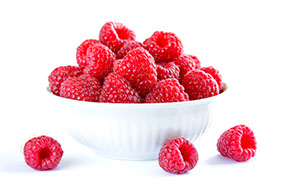Overview
Compatibility & Temperature
Grade Tolerances
Nutrition Information
Raspberry
Raspberries are grown for the fresh fruit market and for commercial processing into individually quick frozen (IQF) fruit, purée, juice, or as dried fruit used in a variety of grocery products.
Traditionally, raspberries were a mid-summer crop, but with new technology, cultivars, and transportation, they can now be obtained year-round. Raspberries need ample sun and water for optimal development. Raspberries thrive in well-drained soil with a pH of between 6 and 7 with ample organic matter to assist in retaining water. While moisture is essential, wet and heavy soils or excess irrigation can bring on Phytophthora root rot which is one of the most serious pest problems facing red raspberry. As a cultivated plant in moist temperate regions, it is easy to grow and has a tendency to spread unless pruned. Escaped raspberries frequently appear as garden weeds, spread by seeds found in bird droppings.
An individual raspberry weighs 3–5 g (0.11–0.18 oz), and is made up of around 100 drupelets, each of which consists of a juicy pulp and a single central seed. A raspberry bush can yield several hundred berries a year. Unlike blackberries and dewberries, a raspberry has a hollow core once it is removed from the receptacle.


Compatibility
Group 1. Ice never recommended. For more details on Group 1, visit http://www.ams.usda.gov/tmd/export/ compatibility.htm
Temperature
USDA recommended storage and transit: 32°F (O.O°C)
Desired relative humidity: 90 to 95 percent Highest freezing point: Black 30°F (-1.1°C) Red 30.9°F (0.6 °C)
Raspberries are perhaps the most perishable of all produce commodities with expedited delivery times and exact temperature maintenance a requisite for good arrivals. Under ideal circumstances, shelf life rarely exceeds a few days, and any breach of ideal conditions will severely reduce shelf life.
As indicated above, raspberries should be held as near 32°F as is practical. At higher temperatures they will soften and decay rapidly. Since berries are held near freezing temperatures, frozen berries and berries affected by freezing injury may be seen in the marketplace. Such berries will appear as dull, watery and translucent, with the berries being soft and leaky when removed to room temperatures.
Sources: The Produce Blue Book

Suitable Shipping Condition/
F.O.B. Good Delivery Guidelines
15% total including
8% serious including
3% mold or decay
Nutrition Facts
Serving Size 1 cup
Amount Per Serving
Calories from Fat 7Calories 64
% Daily Values*
Total Fat 0.8g 1%
Saturated Fat 0.023g 0%
Polyunsaturated Fat 0.461g
Monounsaturated Fat 0.079g
Cholesterol 0mg 0%
Sodium 1mg 0%
Potassium 186mg
Total Carbohydrate 14.69g 5%
Dietary Fiber 8g 32%
Sugars 5.44g
Protein 1.48g
Vitamin A 1% Vitamin C 54%
Calcium 3% Iron 5%
* Percent Daily Values are based on a 2000 calorie diet. Your daily values may be higher or lower depending on your calorie needs.
Nutrition Values are based on USDA Nutrient Database SR18


Century Farms International, Inc.
10957 NW 123rd Street Medley, FL 33178
Office: 305-436-7971 Fax: 305-436-7968



